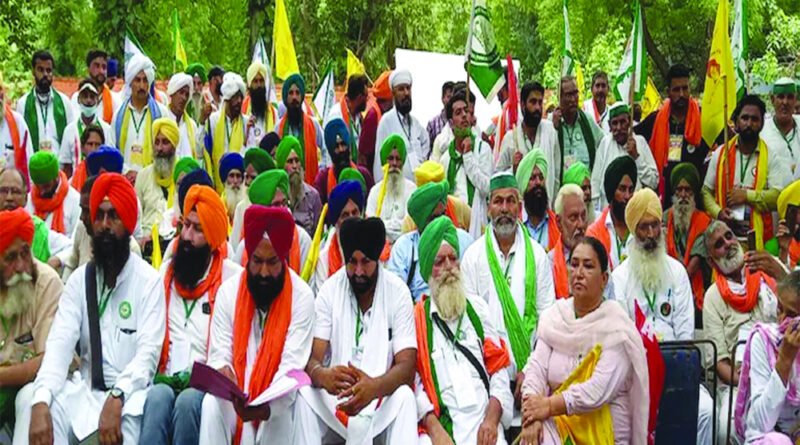Farmers’ movement emerges stronger
The recent Kisan Sansad at Jantar Mantar broke fresh ground in support of the movement and in highlighting the Union Government’s failure
It’s quiet and peaceful once again as you take Tolstoy Marg walking past Imperial Hotel toward Jantar Mantar. Fewer khaki shirts patrol the area. No more communal sloganeering or protests. But the dozens of yellow police barricades kept on the one side did tell a tale, something happened here.
From July 22 to August 9, the farmers’ revolution leaders had organised a Kisan Sansad (Farmers’ Parliament) at Jantar Mantar. It ran parallel to Indian Parliament’s monsoon session. Each day, 200 farmers’ representatives deliberated on farm laws and other issues like “MSP as a legal right”, the “Swaminathan Report” and even introduced a “no-confidence motion” against the Modi Government.
But what did this symbolic Sansad achieve? First things first, with the Sansad, the farmers’ revolution has entered Delhi’s heart. And it showed the nation that farmers can also conduct a parliament. The voices from farmers’ camps now roared inside Delhi and Indian democracy’s rudder seemed to turn. Now whether the farmers got police permission as Balaji Shrivastava’s (Delhi Police ex-Commissioner) farewell gift to Modi or their leaders’ astute politicking can be debated upon. But definitely, the Government was on the back foot.
Why would one infer that? The security measures were the first indicator. There were five security personnel for every farmer representative. The media was often segregated, freelance journalists denied entry, and one day many were barred from re-entry, all done unofficially, of course.
Some things fell in the farmers’ favour, too, starting with a stormy monsoon session. Pegasus had rocked the House and yet the Government was in no mood to discuss snooping or farm laws. While crores were wasted in Parliament, the Kisan Sansad held debates and discussion each day. New faces participated in these sessions. Renowned agri experts like Devinder Sharma and Ranjit Singh Ghuman also lent a hand. Former bureaucrats, singers and an actress, too, participated in the proceedings.
The Kisan Sansad was successful in becoming the melting pot and new coalition for political actions. When the representatives introduced a no-confidence motion, to everyone’s awe over 60 MPs from the Opposition parties led by Rahul Gandhi sat in the visitors’ gallery, giving tacit support to the revolution. This event has given a new platform to political fringe groups, too, and many of us were reminded of the JP movement days.
Speaking of political fringe groups, the Kisan Sansad gave a platform to women’s issues. For two days, it transformed into an all-women affair. Issues of essential commodities Act, women’s reservation and security were discussed during these days. The farmer leaders gave special importance to women and have been successful in garnering their support.
Apart from being a great PR campaign against the Modi Government, the Kisan Sansad played an important role in galvanising its own cadre. The hardest part of the long-drawn movement or war is attrition. The Kisan Sansad, with the help of vernacular online media, kept the morale high. Jantar Mantar gives the farmers a new hope. Alarmed by the farmers’ success, anti-social elements inexplicably evaded the police cordon and entered the area on August 8, chanting communal slogans. This may seem as a direct challenge to the farmers but, instead of demoralising them, it spread more distrust among them for the Modi Government. It has also exposed the doublespeak on COVID and the police’s intentions, too.
Even the splinter group led by VM Singh failed again to have a negative impact. The Kisan Sansad’s message reverberated even inside the splinter groups’ meetings. The overall motivation in the camps and hinterland is strengthened.
But the biggest achievement is that the farmers have started a purely political process. From a grassroots movement about fair prices and agrarian issues, the revolution has evolved into a budding political movement. It has also given the farmers a taste of parliamentary sessions and democracy. The tacit message sent across the country is that the farmers need to get ready to enter Parliament.
During the late 1990s, VP Singh had clearly predicted: “Till the farmers don’t become a political class, no one will listen to them. They must enter politics themselves.” Today, the Kisan Sansad is a stepping stone. Farmers’ revolution has already started to organise farmers across the country as one political class and, in the process, even laying the foundation stone for ‘Green Politics’. Naturally the movement is stronger in Punjab, Haryana, UP and parts of Rajasthan but other States are being added to the list.
Despite the farmer leaders saying otherwise, “Mission UP” is highly political. It starts with a mega farmers’ rally on September 5. The leaders themselves have revealed that campaigns will begin in all 18 sub-regions to bolster the anti-BJP wave. The farmer leaders previously travelled to West Bengal and aided Mamata’s victory in the State. UP will be the final test; if successful, the farmers’ revolution will have a major impact on Indian politics. Whether the BJP wins or loses, the Kisan Sansad and revolution herald a new age for farmers’ movement and agrarian politics in India.
(The author writes on agriculture and environment, and is a former Director — Policy & Outreach, National Seed Association of India. The views expressed are personal.)
Source: PTI




